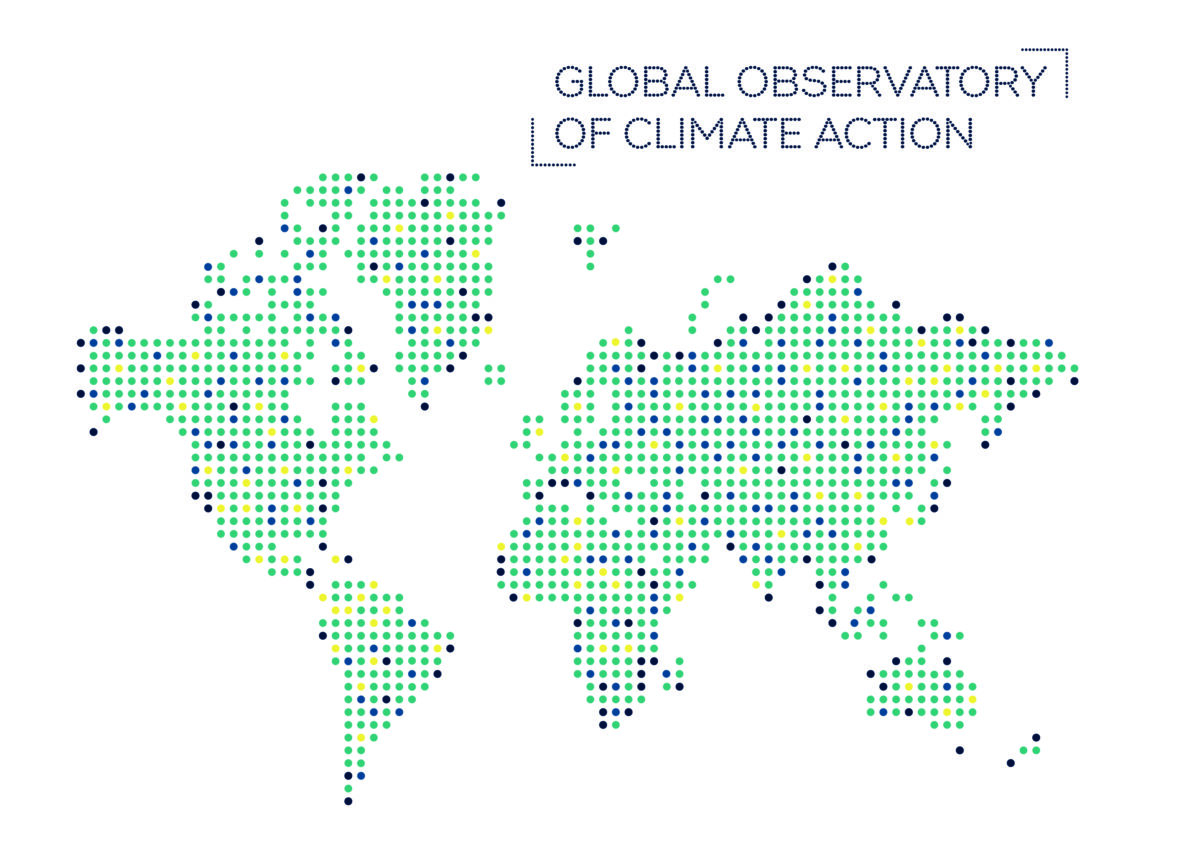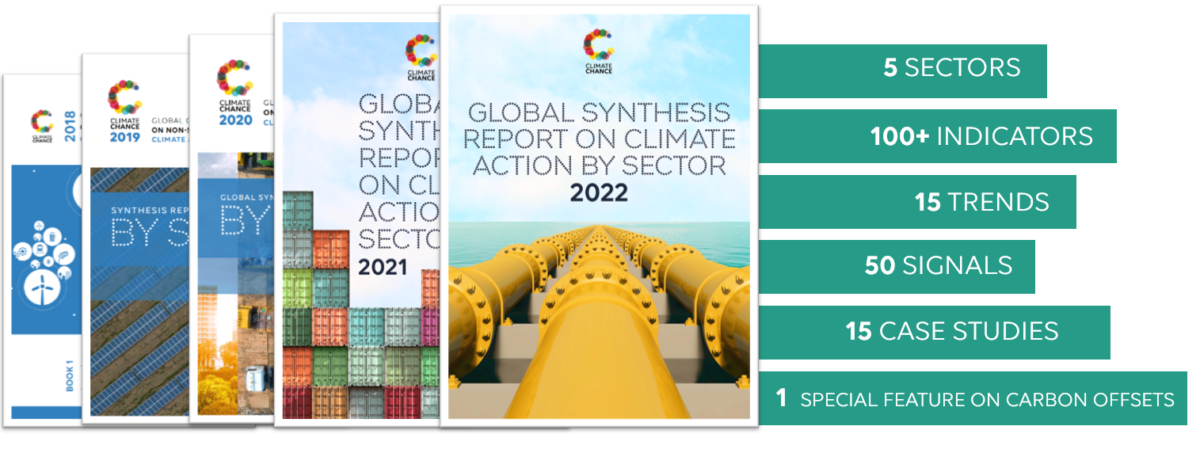What is the Climate Chance Observatory?
Since its creation in 2018, every year the Observatory publishes a Global Synthesis Report on Non-State Climate Action, an overview of the major global trends in the actions successfully carried out by local authorities, businesses and NGOs, case studies and analysis notes. The Observatory of Climate Action in Africa was launched in 2022.

Why create an Observatory of Non-State Climate Action?
Despite the IPCC’s warnings of the severity of the climate catastrophe, greenhouse gas emissions continue to rise and the aggregation of commitments made by States at COP 21 predicts that temperatures will rise by more than 3 °C in the 21st century, calling for action today.
The mobilisation of non-state actors (local authorities, businesses, NGOs…) and the multiplication of the projects and strategies they develop are not only a reason for hope, but are also essential if we expect to achieve a carbon-neutral world by 2050 while ensuring the essential needs of populations.
In 2018, Climate Chance launched the Global Observatory of Non-State Climate Action to understand where the most interesting dynamics lie: at the intersection of national public policies with the mobilization of actors, in the initiatives of networks of local authorities, in the involvement of the world of finance and the evolution of its instruments.
With its unique global publications of reference for decision-makers, every year, the Climate Chance Observatory analyses and synthesises the climate action actually carried out by local governments, businesses, civil society and financial actors to reduce their emissions and adapt to climate change.
Since 2022, Climate Chance has been developing the Observatory of Climate Action in Africa, a regional application of the methodology of the Global Observatory of Climate Action, specifically for non-state actors in Africa.
Ronan Dantec, President of Climate Chance
“It is one of the only reports to study, not the commitments of States, but first of all, the reality of the evolution of greenhouse gas emissions and the impact, on this trajectory, of concrete actions carried out in the territories and economic sectors.”
A unique global overview for decision-makers
4 thematic reports, on a global scale
- Sector-based Report: The Observatory’s flagship report, renewed and presented each year at the time of the COP, which presents a complete overview of the actions taken by businesses, local governments and civil society to reduce their emissions and adapt to climate change on a global scale. It analyses and tracks evolution of CO2 emissions in light of the actions carried out by non-state actors in the major GHG emission sectors (energy, transport, buildings, industry, waste, land use).
The Sector -based Report contains: A double-page spread of indicators and infographics to understand the evolution of emissions and the main drivers of the transition in each sector, based on objective data on emissions and actions taken; the main sectoral trends in climate action that have marked the past year; case studies and remarkable initiatives that make it possible to identify the most effective levers for progressing towards a low-carbon society; emerging signals of action that prefigure tomorrow’s trends today. The Sector-based Report has received recognition and visibility among the climate community and the media.
Find the latest edition (2022) here

3 other reports are published regularly:
- Local Action Report: Analysis and monitoring of the main results and climate initiatives of local authorities, cities and regions.
Find the latest edition (2022) here - Climate Finance Report: Analysis and monitoring of climate action led by financial players: banks, insurers and investors, produced in partnership with Finance for Tomorrow (now the Institute for Sustainable Finance).
Find the latest edition (2022) here - Adaptation Report: State of play, data monitoring and strategies reporting on how local governments adapt, published in partnership with Comité 21.
Find the latest edition (2019) here
The Observatory’s objectives:
- Showing climate action as it is, not as it should be. Commitments, projections and recommendations are not part of its scope of analysis.
- Telling the story behind the figures by providing a qualitative and quantitative analysis of the evolution of GHG emissions through the action trends of the different actors, in the main emission sectors, and at different levels of governance (national, regional, local).
- Positioning itself as a reference tool by synthesising multiple sources (scientific papers and reports, grey literature, corporate reports, press articles, etc.).
- Being a toolbox for project leaders, private and public decision-makers by disseminating best practices and promoting the contributions of stakeholders to the achievement of the Paris Agreement and SDGs.
With the Climate Chance Observatory, the association continues its mission of observing the implementation of announced actions, monitoring the evolution of emissions and analysing the strategies of actors in relation to international climate objectives.
In their words:
“Congratulations for the Report of the Climate Action Observatory, a mine of information, a very useful tool for reflection.” – Brigitte Collet, Ambassador for France on climate negotiations
“We cannot dissociate State and non-State actors in silos, success requires a synergy between public policies, local authorities and civil society, and this is the message conveyed by Climate Chance in this Report.” – Jean Jouzel, Honorary President of Climate Chance, climatologist, former Vice President of the IPCC scientific group
“Bravo to the Climate Chance Observatory for capturing the complexity of the sector in so few pages. Reading the transport section of the 2019 Report avoids reading hundreds of pages in English from different reports. A very useful meta-synthesis.” – Claire Bernard, from the Michelin Foundation
“Congratulations on this robust Report, we have rarely seen such a comprehensive report in French with all these references. AFD will use it to carry out an exercise to mainstream climate change concepts through the initiatives and actions it identifies.” – Christophe Buffet, from AFD’s Adapt’Action Program
The Global Observatory of Non-State Climate Action
Annual reports: Sector-based Reports, Local Action Reports, Climate Finance Reports and Adaptation Reports.
HEREThe Observatory of Climate Action in Africa
Our analysis of trends and initiatives for climate change mitigation and adaptation in Africa.
HEREOther publications of the Climate Chance Observatory
Country, city or region case studies
Our case studies analyse the recent evolution of emissions in a sector or adaptation action, in a country, city or region.
HEREAnalysis notes
The Observatory’s blog contains notes, articles and contributions, published over the course of the year, on substantive and topical subjects, linked to the events that mark the year (negotiations, regulations, etc.)
HERE


